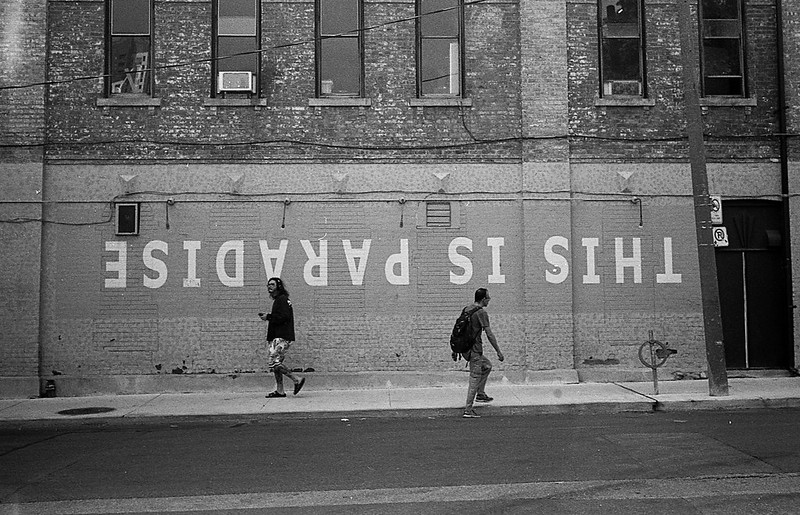THE BRIGHT FIELD
I have seen the sun break through
to illuminate a small field
for a while, and gone my way
and forgotten it. But that was the
pearl of great price, the one field that had
treasure in it. I realise now
that I must give all that I have
to possess it. Life is not hurrying
on to a receding future, nor hankering after
an imagined past. It is the turning
aside like Moses to the miracle
of the lit bush, to a brightness
that seemed as transitory as your youth
once, but is the eternity that awaits you.
—
 Start by-hearting poems and soon you’ll find yourself in a conversation with someone on Twitter wanting to know what technique you’ve been using to commit your 12,000 words of verse to memory.
Start by-hearting poems and soon you’ll find yourself in a conversation with someone on Twitter wanting to know what technique you’ve been using to commit your 12,000 words of verse to memory.
“Have you tried the method of loci?” enquires Ian (“Poet, Artist, and Writer. @UCBerkeley alum slummin’ in Dublin”) stopping one May morning to inspect a fresh rabbit dropping otherwise known as a tweet in which I’ve mentioned my project.
The Method of Loci (MoL for all you budding cognitive neuroscientists out there) is a mnemonic device that uses visual imagery to link together a series of tangentially related bits of data in a way that the human mind can contain more information than you would expect this lump of meat we call our brains might hold. Data such as a portion of the trillion digits following a decimal place which is used to represent π is an example of this. Milton’s Paradise Lost is another.
The ardent Memory Master or Mnemonist will allocate information such as numbers or words to the loci (locations) of a familiar route or maybe the layout of rooms in a building she knows well, or even to objects and furniture in those rooms. Thereafter, by mentally retracing the route, the Mnemonist will have a series of retrieval cues for this data, “so that the order of the places will preserve the order of the things, and the images of the things will denote the things themselves” as the Roman statesman and philosopher Marcus Tullius Cicero explains in De Oratore, a text that first introduced us to this technique 2,000 years ago.
The reason Ian is asking about MoL is not because MoL is particularly useful for remembering a poem. A poem is not a series of random digits or facts, it already has a somewhat cohesive shape and music to it, and even a specifically poetic narrative which might assist us with our memorising.
But as with most exchanges on Twitter, Ian’s main purpose for enquiring about MoL is as a pretext for him to showboat his own use of MoL to memorise Merwin’s 12-line poem Rain Light, which seems to me a bit like using a jackhammer to crack a walnut. I don’t say this to Ian however because Poetry Twitter, unlike the rest of Twitter, is a predominantly supportive and benign environment, populated for the most part by time-wasting neurotics and blatherskites, myself and Ian being two lesser-known illustrations of this, all of us publicly tolerating each other whilst pro-socially backslapping our inconsequential and largely unread outputs in prose and especially in verse.
 Of all the memorisation techniques out there, MoL doesn’t seem especially useful when it comes to learning poetry. Not even Akira Haraguchi, who has memorised over 100,000 digits of pi uses MoL. Instead he turns those 100,000 digits into a kind of poem! He does this by associating each number with a syllable and then creates poem-like narratives from the words produced by those syllables.
Of all the memorisation techniques out there, MoL doesn’t seem especially useful when it comes to learning poetry. Not even Akira Haraguchi, who has memorised over 100,000 digits of pi uses MoL. Instead he turns those 100,000 digits into a kind of poem! He does this by associating each number with a syllable and then creates poem-like narratives from the words produced by those syllables.
“I have created about 800 stories, whose lead characters are mostly animals and plants,” he explains. “For the first 100 digits of pi, I have crafted a story about humans. Here is how the first 50 digits, starting with 3.14, reads: “Well, I, that fragile being who left my hometown to find a peace of mind, is going to die in the dark corners; it’s easy to die, but I stay positive.”
His quest to learn as many of the pi digits is not that dissimilar to my own more diminutive challenge of memorising 100 poems. For both of us it is a spiritual practice at best, but also a time-dissipator, a wordy or digity mantra, helping us to focus our wayward minds by calling into being, if only as an echoing abstraction, the whole known and unknown universe, including that of consciousness, through a rotating prayer of atoms and spinning electrons, circumvolving planets and galaxies. Which in one way is wonderful, and in another way completely nuts. Haraguchi’s family are not interested in pi, and my family are not interested in poetry. They see his quest rather, as no doubt do mine, as “an enormously harmless hobby”.
But I think R.S. Thomas would have appreciated Haraguchi’s quixotic focus of interest, which also chimes so well with this poem.

My experience of learning poetry by heart is that the relationship between the words to be learned and the arbitrary psychogeography one might choose for those words to be associated with, functions antithetically to traditional MoL. Often when I am reciting certain poems, the landscapes I had unspooling around me whilst I learnt the poem return as confederates to the words that once inhabited them.
In my mind, Wendell Berry’s The Peace of Wild Things will always be associated with the river Chess near Latimer Park farm. Similarly James Wright’s Lying in a Hammock at William Duffy’s Farm in Pine Island, Minnesota reminds me of walking on a narrow path, hedges on both sides near Leyhill Common, unaware that the route ahead was going to be closed by roadworks, resulting in half an hour of scramble with a small dog in my arms over 3 metre high temporary mesh-fencing panels in a bid to break out. I don’t know why I am telling you this. Maybe just to reiterate that I’m not at the moment using any formal system for learning the 10 or 12,000 words that will eventually make up my 100 poem Poetry Liturgy.
How I learn a poem is like this. I read the first line or two. I repeat it, I repeat it, I repeat it. I think about it, savour it, play with different ways of saying it, often imagine what is being presented a visual image. I repeat the line again and again. I then add another line and do the same. I go back to the first line and notice I’ve forgotten that, so I begin again: repeating, savouring, thinking, visualising, trying out different combinations of emphasis and articulation. I do this for a while until I have a few lines going. I then add a bit more, until maybe I’ve got what feels like one semantic unit. In Bright Field, that first unit might be:
I have seen the sun break through
to illuminate a small field
for a while, and gone my way
and forgotten it.
I start to notice the unique physicality of each clause, as you might recognise the ways in which another human being walking alongside you uses their limbs, and how those limbs are shaped.
 Thomas’s language is pared down to the bone: it is taut, and wiry and matter-of-fact. You see this especially in “and gone my way / and forgotten it”. The discursive mind wants to add other words to these two clauses, perhaps repeating the auxiliary verb “have” in the first line alongside an adverb to make “and have gone on my way”. The mind is always doing this when learning poems: coming up with more fleshed-out, sociably padded additions (“and forgotten about it”?). The poem reminds its learner again and again, this one certainly does, that it is not a Barbie Doll or Action Man to be dressed up or prettified, but rather exists as a Hepworth or Moore, or Giacometti statue exists: with only the most necessary, elemental contours present to us. Which works especially well for this poem as so much of it is about working out what really matters in our life: those transitory but intrinsically meaningful illuminations which disturb, often serendipitously, the grinding mundanity of being alive.
Thomas’s language is pared down to the bone: it is taut, and wiry and matter-of-fact. You see this especially in “and gone my way / and forgotten it”. The discursive mind wants to add other words to these two clauses, perhaps repeating the auxiliary verb “have” in the first line alongside an adverb to make “and have gone on my way”. The mind is always doing this when learning poems: coming up with more fleshed-out, sociably padded additions (“and forgotten about it”?). The poem reminds its learner again and again, this one certainly does, that it is not a Barbie Doll or Action Man to be dressed up or prettified, but rather exists as a Hepworth or Moore, or Giacometti statue exists: with only the most necessary, elemental contours present to us. Which works especially well for this poem as so much of it is about working out what really matters in our life: those transitory but intrinsically meaningful illuminations which disturb, often serendipitously, the grinding mundanity of being alive.
So I work on that initial unit until each line comfortably cues the next in my memory. Whilst doing this, my mind might wander, so that when I come back I find only a few words have remained. I might get annoyed at myself at this point, at my blob-of-meat mind and start all over again. Because I have already introduced the words before, spent some time with them, the second time around they are more swiftly retainable. I then try and work on the next semantic unit, and see if I can solder it in some way to the first.
But that was the
pearl of great price, the one field that had
treasure in it.
“OK, so there’s a contrasting preposition here,” I show myself, “remember that the next time you come to the end of the first unit. Notice also,” I tell myself, “the alliterations “pearl of great price”, also hurrying/hankering and Moses/miracle.” Alliterations are a godsend to the poetry mnemonist, as are all conjunctions, often rendering two into one.
While I am caught up with the physicality of each line, its structure and articulation, the act of repetition begins to drive the import of the words deeper and deeper in my mind and heart. These underscore key lines like an exclamatory, concordant YES!!!, a euphoric primal punctuation of core understanding.
But that was the
pearl of great price, [YES!!!]
(I decide to really stress the “that” in this line)
the one field
(ditto with “one”)
that had
treasure in it [YES!!!]
I realise now
that I must give all that I have
to possess it.
[YES!!!]
[YES!!!]
[YES!!!]
 This is what it feels like (from the inside) to learn by heart a poem that you love. Perhaps, not by mistake, all those ecstatic YESes start sounding like the soundtrack to a disincarnate porn film. And maybe this is not a glib analogy. For just as evolution has shaped us to feel most apropos (literally, to purpose) when we are feeding the animal body, fucking or being fucked with the animal body, moving it in pursuit or play, so the “treasure” of committing words to the heart, words that are closely in sync with our own experience, and maybe even numbers as in Haraguchi’s pi-quest, feels very much on par with the Peak Experiences of both transcendental religious worship and sex, as sketched out by Maslow about 50 years ago.
This is what it feels like (from the inside) to learn by heart a poem that you love. Perhaps, not by mistake, all those ecstatic YESes start sounding like the soundtrack to a disincarnate porn film. And maybe this is not a glib analogy. For just as evolution has shaped us to feel most apropos (literally, to purpose) when we are feeding the animal body, fucking or being fucked with the animal body, moving it in pursuit or play, so the “treasure” of committing words to the heart, words that are closely in sync with our own experience, and maybe even numbers as in Haraguchi’s pi-quest, feels very much on par with the Peak Experiences of both transcendental religious worship and sex, as sketched out by Maslow about 50 years ago.
Peak experience, of which this poem not only seeks to give us a taste of, but also exemplifies in itself and as itself can be described through a number of different variables. Some of these include:
- a disorientation in time and space, alongside a non-comparing acceptance of everything, as if everything were equally important
- an ego-transcending, self-forgetful, unselfish vision of the natural world and our place in it
- a self-validating, self-justifying perception which carries its own intrinsic value with it lending itself to the operational definition of the statement that “life is worthwhile” or “life is meaningful.”
Pretty cool, huh? Which is why I continue to spend at last an hour, 10% of each awake-and-conscious day, “giving all that I have” to possess the 100 words or that make up poems like this one.
Specifically, what I think I give to the process is patience, or an attempt at patience (not my strongest suit), which is perhaps more about tolerating the Sisyphean frustration of forgetting, accompanied by a kind of relentlessly romantic stick-to-itiveness. Stick-to-itiveness, resilience, grit, is a virtues that I possess for only a two or three things in my life. But maybe that is enough to reconcile me to the burden of being alive.
I’m not yet sure if it is enough to take me into a consciously transcendent state akin to the utopian promise of heaven alluded to at the end of the poem. Non-theist that I am, I would prefer to perceive that illuminated eternity as available to me intermittently when I am in the flow of reciting words that have become, through thousands of repetitions, as germane to my lived experience as a glass of water when thirsty, or food/sex when hungry for it. It doesn’t always feel that way, but when it does, this reinforces my desire to keep on doing this.
But like all peak experiences: as the moniker suggests, the only way to know it, is to experience it. Which is why, evangelical-like, I urge you when you’ve finished reading these words to find a poem you love and start learning it by heart.

